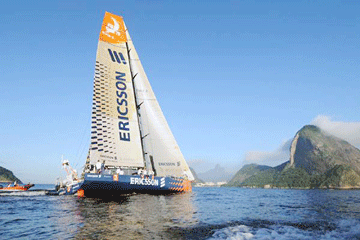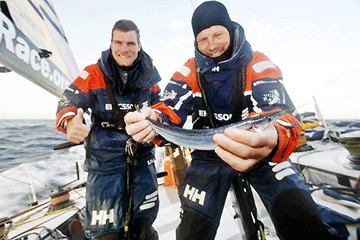
| Volume XVII, Issue 15 - April 9 - April 15, 2009 |
Two-Thirds Around the Globe
The Volvo Ocean Race, Leg 5: 41 Days, 12,300 miles
by Steve Carr
We left the reduced Volvo fleet of five boats [www.bayweekly.com/year09/issue_10/lead_3.html] heading south from China, with Ericsson 4 and Puma leading the way toward the tricky, windless void known as the Doldrums, which drifts along the equator.
The five remaining boats punched through the dead zone to the next obstacle: the Fiji Islands. Three fanned out east and west — while Puma and Telefonica Blue made a daring run up the middle of the poorly charted shallows between the two biggest islands, Viti Levu and Vanua Levu.
 |
Ericsson 3 on the home stretch, left, and approaching the finish line at Rio de Janeiro after an epic 41 days of sailing in Leg 5. |
Ericsson 3 Writes History
What happened next will be talked about for years to come. World records are set in the Roaring 40s of the Southern Ocean. The Volvos are designed for these conditions: 60-knot winds and 20-meter seas blasting off Antarctica and pushing the boats east to Cape Horn like the hand of God.
“The next two weeks that we’ll be spending in the Southern Ocean, the jewel in the crown of the race … [where people] test themselves against the best sailors in the world in the most extreme sailing conditions,” wrote Puma’s Rick Deppe.
Entering the Southern Ocean, Ericsson 3 skipper Magnus Olsson followed the risky strategy of his rookie navigator Aksel Magdahl, banging a hard left, heading northeast and slingshotting over the top of a nasty low-pressure system. The rest of the fleet followed conventional wisdom and powered south.
Telefonica Blue skipper Bouwe Bekking’s reaction to Ericsson 3’s play echoed the rest of the skippers. “They are showing balls, hats off to them. If that northerly route wins them the leg, they will write history.”
The race committee positioned two longitudinal ice gates along the west-to-east route to prevent the boats from going too far south and colliding with an iceberg. Even so, Green Dragon encountered three icebergs the size of football fields on a pitch-black night in the middle of the Southern Ocean.
When the boats came together at the second gate, Ericsson 3’s bold northern gambit had paid off: They were almost 300 miles ahead of their nearest competitor, Ericsson 4.
Limping Home
Conditions onboard the boats had gotten cold, wet and ugly. With crews tossed like rag dolls, strategy took a back seat to survival.
 |
Crew aboard Ericsson 3 catch fish to supplement dwindling food supplies. |
![]() Telefonica Blue couldn’t hold up to the stress. First the main sail began to delaminate; then the forestay — which holds the entire rig together — broke. Thousands of miles from land, the crew valiantly pressed on with a jury rig. But their race was effectively over.
Telefonica Blue couldn’t hold up to the stress. First the main sail began to delaminate; then the forestay — which holds the entire rig together — broke. Thousands of miles from land, the crew valiantly pressed on with a jury rig. But their race was effectively over.
After the curves thrown by the Southern Ocean, rounding the 1,400-feet-high fire rock known as Cape Horn was anticlimactic. As the sea bottom goes from 4,000 meters to 70, waves and williwaw winds are usually off the scale. But conditions were fairly calm as the first boats left the Pacific and entered the Atlantic through the Le Maire Strait in the dark on St. Patrick’s Day. Ericsson 3 led, followed by Ericsson 4 three hours behind.
The fleet swung northeast toward the Falkland Islands, riding the Malvinas Current in a steady westerly breeze, collectively choosing the inside track between South America and the islands where Britain and Argentina fought a spectacular naval battle in the spring of 1982.
High-pressure booby traps danced across the path of exhausted crews and crippled boats. Puma had a damaged steering wheel. Ericsson 4’s hydraulic keel was leaking oil on starboard tack. And food was running out.
Green Dragon skipper Ian Walker sounded the alarm. “When guys are tired and hungry, there is nothing like food to create friction between them. As of today, to prevent any arguments over who has eaten what, we are splitting the food 11 ways and leaving each individual to manage their own food. We are already hungry and it will get worse.”
Several of the boats supplemented their dwindling supplies by catching fish.
The wind gods finally showed mercy on the fleet, which sailed into Guanabara Bay in the same order they had rounded Cape Horn. Ericsson 3 had started almost a day behind but won.
Two-thirds of the way around the globe, Ericsson 4 has a 10.5 point lead over the American entry Puma, with Telefonica Blue another 3.5 behind in third and Ericsson 3 still 10 behind in fourth. But almost half the points are still in play. Watch these pages for the next leg, from Rio to Boston.